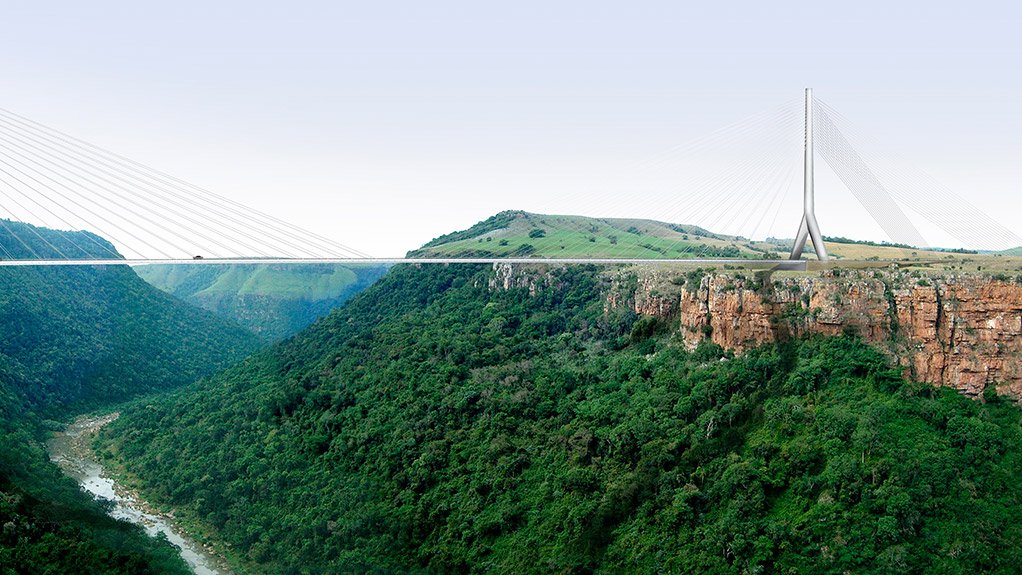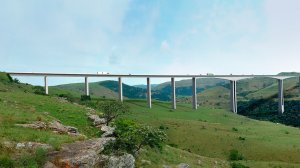Two significant mega-bridges on their way
This article has been supplied as a media statement and is not written by Creamer Media. It may be available only for a limited time on this website.
Throughout the centuries bridges have fascinated people. Their purpose is self-evident as being the link between transportation routes be they footpaths, railways or roads. Although the primary purpose is functional and safe to use, a bridge can be a thing of beauty. World-wide there are bridges that have become tourist attractions in their own right. People are captivated by bridges, especially large bridges.
Of the 750 000 kilometres of roads in the country, some 22 000 fall under the jurisdiction of the South African National Roads Agency SOC Pty Ltd (SANRAL) – with approximately 9 500 bridges and major culverts.
Two spectacular mega-bridges called the Msikaba River Bridge and the Mtentu River Bridge – on the new N2 Wild Coast Highway - are about to be added. The first steps towards making this a reality were taken recently in inviting tenders. Apart from making a major contribution to transport infrastructure and to the well-being of the people who live along the new greenfields portion of the N2, they will also be true landmarks of international note.
These two bridges transverse the Msikaba and Mtentu rivers and are vital links in the Wild Coast Highway project between East London in the Eastern Cape and Port Edward in KwaZulu-Natal.
The designs of the bridges are complete, but due to the size and complexity of the two structures, the tender process will only be finalised towards the end of the year. Construction will begin early next year.
The Msikaba River Bridge will be a 580m single span cable-stayed bridge. It is a unique, spectacular structure that crosses a deep, forested gorge with high sandstone cliffs flanking its sides.
At no stage will work be done in the gorge and construction will commence from each bank to eventually be joined in the centre. The bridge is 192m above the river and constructing at these heights requires specialised techniques.
Some 18 km north of the Msikaba River is the proposed Mtentu River Bridge. A vehicle crossing this bridge will be 223m above the river. The bridge will be a 1 132m long concrete structure with a balanced cantilever main span of 260m. This will be one of only a few such large concrete balance cantilever bridges with spans of 260m or more in the world.
The bridges and the highway project will be a catalyst for local development, bringing direct and indirect business opportunities, boosting small and medium enterprises while connecting local communities with each other as well as bigger towns along the road. It will also make the Wild Coast tourist attractions more accessible. Both structures will be attractive with their clean, functional lines and are bound to become tourist attractions complimenting the natural beauty of the area.
People will stop to view the bridges and then also see the natural beauty of the valleys they cross. Pedestrian walkways with safety screens will be provided on both sides of each bridge. Disabled people will also be able to access the structures and thus see the magnificent views off the bridges. In addition, view sites will be constructed for the public to see not only the bridges but the natural beauty of the environment.
As with all SANRAL bridges, safety as well as the aesthetic and environmental issues played a major role in the planning, design phase and the future construction of the Msikaba and Mtentu bridges. This will certainly be the case for the all road and bridges on the Wild Coast Highway.
An example of what care will be taken environmentally is the way the construction of the bridge over the Barberspan Canal, between Delareyville and Sannieshof in the North West province, was handled.
It is one of 18 sites in South Africa recognised in terms of the global Ramsar Convention on Wetlands. Special care was taken: the water quality was tested monthly and a birdlife specialist undertook similar counts of the thirty bird species in the immediate area of the bridge.
The contractor ensured that a rare colony of cliff swallows established underneath the old bridge was not disturbed and the structure was sold to the local nature reserve to be managed.
The lifespan of a bridge can be anything between fifty and a hundred years. SANRAL-accredited inspectors check all bridges and major culverts every five to six years. Repair work is then prioritised on the basis of risk. If properly maintained, bridges can last much longer. SANRAL has its own code of practice for the design of bridges with which all designs must comply. South African bridge design codes have their basis in international codes.
Quality starts with the initial concept designs that later set the groundwork for the construction of the roads and bridges. South African engineers are right up there with the best in the world when it comes to both the design and construction of bridges.
The design and construction of these two new bridges in the Eastern Cape will be subject to all of these stringent procedures - and will end up being environmentally friendly, aesthetical highlights and safe.
Edwin is the Bridge Network Manager of the SA National Roads Agency (SANRAL)
Comments
Press Office
Announcements
What's On
Subscribe to improve your user experience...
Option 1 (equivalent of R125 a month):
Receive a weekly copy of Creamer Media's Engineering News & Mining Weekly magazine
(print copy for those in South Africa and e-magazine for those outside of South Africa)
Receive daily email newsletters
Access to full search results
Access archive of magazine back copies
Access to Projects in Progress
Access to ONE Research Report of your choice in PDF format
Option 2 (equivalent of R375 a month):
All benefits from Option 1
PLUS
Access to Creamer Media's Research Channel Africa for ALL Research Reports, in PDF format, on various industrial and mining sectors
including Electricity; Water; Energy Transition; Hydrogen; Roads, Rail and Ports; Coal; Gold; Platinum; Battery Metals; etc.
Already a subscriber?
Forgotten your password?
Receive weekly copy of Creamer Media's Engineering News & Mining Weekly magazine (print copy for those in South Africa and e-magazine for those outside of South Africa)
➕
Recieve daily email newsletters
➕
Access to full search results
➕
Access archive of magazine back copies
➕
Access to Projects in Progress
➕
Access to ONE Research Report of your choice in PDF format
RESEARCH CHANNEL AFRICA
R4500 (equivalent of R375 a month)
SUBSCRIBEAll benefits from Option 1
➕
Access to Creamer Media's Research Channel Africa for ALL Research Reports on various industrial and mining sectors, in PDF format, including on:
Electricity
➕
Water
➕
Energy Transition
➕
Hydrogen
➕
Roads, Rail and Ports
➕
Coal
➕
Gold
➕
Platinum
➕
Battery Metals
➕
etc.
Receive all benefits from Option 1 or Option 2 delivered to numerous people at your company
➕
Multiple User names and Passwords for simultaneous log-ins
➕
Intranet integration access to all in your organisation






















